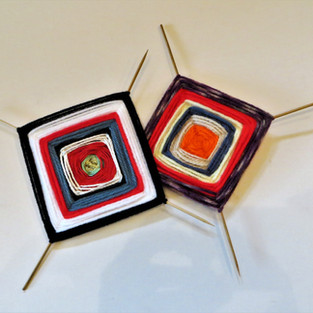By Nancy Albright
Few may know there is a time capsule inside the cornerstone of the South Haven Center for the Arts building—originally the Andrew Carnegie Library—built in 1905.
Architecturally, a cornerstone is the first stone laid in a building’s foundation, which serves as a reference from which to build up. Our cornerstone sits on the northeast corner of the building, and according to an article published in the South Haven Daily Tribune on Friday, October 6, 1905, the stone was swung into place at two o’clock on that day by project foreman O. M. Foster and the Reverend W. P. Law. According to the paper, Library Board President W. S. Bradley was delayed and didn’t arrive in time for the ceremony.

X Marks the Spot!
The 8" x 8" x 12" copper box contains what seems an eclectic collection of objects: copies of the Daily and Weekly South Haven Tribune, the Evening Post, and the Citizens Advocate; a copy of the library catalogue; and the calling cards of residents, including Liberty Hyde Bailey, Mrs. H. M. Abell, Ira Smith, E. G. Hill, Mrs. C. B. Crowell, and Reverend Law himself.
People came from far and wide on the Dunkley Williams R.R. Line, which ran from Chicago to Saugatuck, with stops in South Haven and Douglas (in those days Chicago was far!), and some placed their tickets in the time capsule. Tickets from travel on the Pere Marquette R. R. (Muskegon to Holland), and the Big Four R.R. (Benton Harbor to Warsaw, Indiana), lay alongside the Dunkley’s.

Click to see more cool advertisements from The Official Railway Guide: North American Freight Service Edition at Google Books.
Someone contributed a photo of the passenger steamer S.S. Eastland—known as “the Speed Queen of the Great Lakes”—famous for sinking while docked in the Chicago River on July 24, 1915 killing 884 passengers and crew. It was the largest loss of life from a shipwreck on the Great Lakes. The Michigan Steamship Company commissioned the excursion ship in 1902 and it was built by the Jenks Ship Building Company of Port Huron for tourist travel between Chicago and South Haven.

S.S. Eastland, Docked, c. 1911
If you’re inclined to learn more, here’s a link to an article on the Eastland from Smithsonian Magazine: The Eastland Disaster Killed More Passengers Than the Titanic and the Lusitania. Why Has It Been Forgotten? And Chicago Stories: The Eastland Disaster is quite fascinating, as well.
Financial matters may have also been on the minds of those watching the laying of the cornerstone that day. The box holds a Masonic keystone penny from the South Haven Chapter of the Royal Arch Masons, a Philippine ten cent piece, a Confederate five-dollar bill, a Mexican ten cent script, and a tax receipt from Kalamazoo County, dated 1836.

Masonic Keystone Penny. Pennies were manufactured for each lodge.
Last (and likely there is more), the time capsule contains a cannonball from the the Civil War battleground in Fort Sanders, Kentucky, and an arrest warrant dated 1858 for one Elan G. Cole, whereabouts unknown.
After the time capsule was sealed it was placed in the aperture of the cornerstone, and is still safe one hundred and fifteen years later.
by Nancy Albright


















